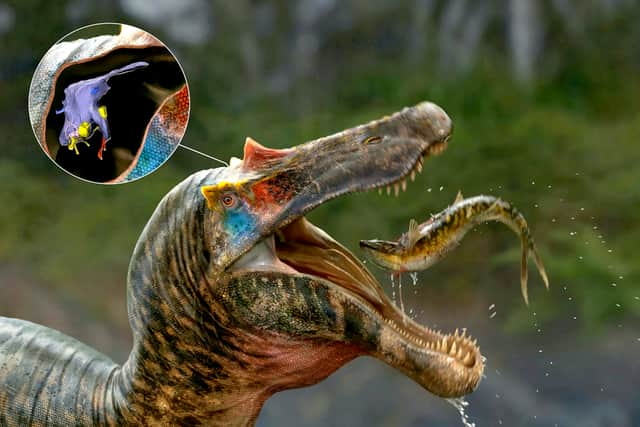UK scientists use groundbreaking technology to unveil brain of biggest ever meat-eating dinosaur
The brain of the biggest meat-eating dinosaur known to have ever lived has been unveiled by scientists. The brain was created by combining the fossilised remains of two spinosaurs dug up on the Isle of Wight and in Surrey in southern England.
The spinosaurs could reach 50 ft (15.35m) long and weigh 20 tons and the predators hunted both on land and in water. They roamed the areas of what are now Guildford and Brighstone Bay near Sandown respectively around 125 million years ago.
Advertisement
Hide AdAdvertisement
Hide AdThe team of scientists reconstructed its grey matter and inner ears by using skulls from individuals known as Baryonyx and Ceratosuchops. The internal soft tissue controlled the carnivore’s sight, smell, coordination, intelligence and even reproduction, and shed new light on the evolution of the biggest land animals to ever roam our planet.
Lead author Chris Barker, a PhD student at Southampton University, said: "Despite their unusual ecology, it seems the brains and senses of these early spinosaurs retained many aspects in common with other large-bodied theropods. There is no evidence their semi-aquatic lifestyles are reflected in the way their brains are organised."
The dinosaur’s olfactory bulbs, which process smells, were not particularly developed, and their ears were attuned to low frequency sounds. The reconstruction also suggests that the parts keeping the head stable and their gaze fixed on their prey were less developed than later, more specialised spinosaurs.
The research also suggests that the spinosaurs ancestors already possessed sensory adaptations and brains suited for part-time hunting for fish in water. All the species had to do to adapt even further to hybrid hunting was evolve an unusual set of teeth and snout.
Advertisement
Hide AdAdvertisement
Hide AdThe spinosaurs stood out among predators for being aquatic as well as terrestrial. Their jaws were long and crocodile-like with six-inch razor-sharp teeth, which enabled them to stalk the riverbanks for large fish to hunt.
Organs such as the brain do not survive fossilisation, so the British and American team working on the reconstruction used CT (computed tomography) scans to peer into preserved cranial cavities. They isolated sections of the dinosaur, filling the gaps of each of the skulls. Putting the regions to provide an accurate 3D representation of the cavities, known as endocast.


Co-author of the study, published in the Journal of Anatomy, Dr Darren Naish, also from Southampton, said: "Because the skulls of all spinosaurs are so specialised for fish-catching, it’s surprising to see such ‘non-specialised’ brains. But the results are still significant. It’s exciting to get so much information on sensory abilities - on hearing, sense of smell, balance and so on – from British dinosaurs.
"Using cutting-edged technology, we basically obtained all the brain-related information we possibly could from these fossils", he added.
Advertisement
Hide AdAdvertisement
Hide AdCo-author Professor Lawrence Witmer of Ohio University, said: "This new research is just the latest in what amounts to a revolution in palaeontology due to advances in CT-based imaging of fossils. We’re now in a position to be able to assess the cognitive and sensory capabilities of extinct animals and explore how the brain evolved in behaviourally extreme dinosaurs like spinosaurs."
Comment Guidelines
National World encourages reader discussion on our stories. User feedback, insights and back-and-forth exchanges add a rich layer of context to reporting. Please review our Community Guidelines before commenting.
